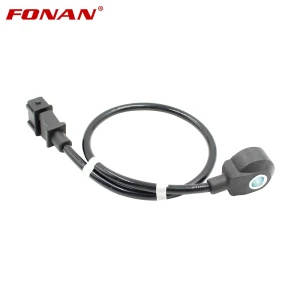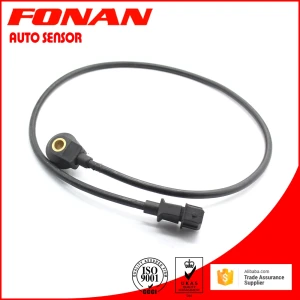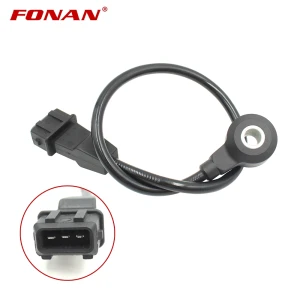Date: 2024.11.02 Click: 702
1. Definition and function of knock sensor
A knock sensor is a device used to detect knock phenomena inside the engine, usually installed on the cylinder block or intake manifold of the engine. Its main function is to monitor abnormal vibrations in the engine combustion chamber in real time and convert these vibration signals into electrical signals and transmit them to the electronic control unit (ECU). By monitoring knock, the sensor can help optimize fuel injection and ignition timing, thereby protecting the engine from potential damage. Its importance is reflected in the following aspects:
Improving engine efficiency: By detecting and adjusting the ignition timing, the knock sensor can help achieve more complete combustion, thereby improving the efficiency and power output of the engine.
Reducing emissions: Optimizing the combustion process helps reduce the emission of unburned fuel, which meets the environmental protection requirements of modern automobiles.
Extending engine life: By timely detecting and preventing knock, the sensor can reduce wear on the internal components of the engine, thereby extending its service life.

2. Working principle of knock sensor
The working principle of the knock sensor mainly relies on vibration sensing, and its basic process is as follows:
Vibration sensing: When the combustion process of the engine is unstable, the explosion of fuel in the combustion chamber will produce high-frequency vibrations. This vibration not only affects the normal operation of the engine, but may also cause damage to components.
Signal conversion: The sensor usually contains piezoelectric materials or accelerometers. When vibration occurs, the piezoelectric material will generate a voltage signal due to pressure changes, or the accelerometer will sense the change in acceleration. The amplitude and frequency of these signals are proportional to the intensity of the vibration.
Signal transmission: The converted signal is sent to the ECU in real time. The ECU analyzes the state of the engine based on the received signal and makes corresponding adjustments, such as changing the ignition timing and fuel injection amount, to ensure that the engine runs in the best condition.

3. Common types and their characteristics
There are many types of knock sensors, each with different working principles and application characteristics:
Piezoelectric sensor: Using the piezoelectric effect, the piezoelectric material inside the sensor will generate a voltage signal when it is vibrated. This type of sensor has a fast response speed, is suitable for use in rapidly changing environments, and can accurately monitor instantaneous knock phenomena.
Accelerometer: Detonation is determined by measuring the acceleration changes of engine components. This sensor can not only detect knocking, but also capture other vibration information, and is suitable for occasions requiring high precision.
Other types: including sensors based on micro-electromechanical systems (MEMS) technology. This type of sensor is small in size and highly integrated, and can provide accurate monitoring in a limited space.

4. Application scenarios and importance
Knock sensors are widely used in modern cars, and their importance is reflected in many aspects:
Engine performance optimization: Knock sensors can monitor knock conditions in real time, help ECU optimize fuel injection and ignition timing, and improve engine power output and fuel economy.
Engine protection mechanism: When knock is detected, ECU will immediately take measures, such as adjusting the ignition advance angle or reducing fuel supply, to prevent knock from causing serious damage to the engine, such as piston breakage and cylinder head deformation.
Fault diagnosis and troubleshooting: When the knock sensor fails, the ECU will receive an erroneous signal, triggering the fault indicator light, prompting the driver to check. This can avoid untimely processing before a serious fault occurs, thereby protecting the engine.
Improving driving experience: By reducing knock, the vehicle can run in a more stable state, improving driving comfort and safety.
5. Common faults and maintenance suggestions
Although knock sensors are generally reliable, some faults may occur during use:
Common fault phenomena: If the engine makes unusual noises, poor acceleration, or the fault light is on, these may be related to the performance degradation of the knock sensor. Especially when driving under high load or at high speed, the sensor is prone to failure.
Maintenance and inspection: Regularly check the sensor and its connecting wires to ensure that they are not loose or worn. When performing oil changes or other maintenance, check the working status of the sensor and replace the faulty sensor in time to ensure its normal operation.
Professional inspection: If you suspect that the knock sensor is faulty, it is recommended to go to a professional repair shop for inspection to accurately determine the problem and perform corresponding repairs.

Conclusion
Knock sensors play a vital role in modern engine management systems. They protect the engine and optimize its performance by monitoring the knock situation in real time. Understanding its working principle, application scenarios and maintenance methods can help car owners better maintain their vehicles and improve driving safety and comfort.
Content reference sources
Automotive engineering related books and technical literature
Industry reports on sensor technology and engine management systems
Official technical information of automobile manufacturers
Please leave your requirements and contact information, and we will send you the quotation information as soon as possible.